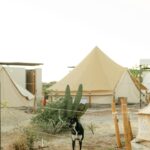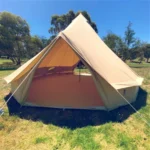As an avid glamper and outdoor enthusiast, I’ve had the privilege of experiencing some truly exceptional glamping locations around the world. The perfect spot combines breathtaking natural beauty with thoughtful amenities, creating an unforgettable escape that feels both wild and luxurious.
Whether you’re planning to open your own glamping business or simply searching for your next adventure, choosing the right location is crucial.
Let’s explore what makes a glamping site truly extraordinary.
Starting or growing your Glamping business can be a stressful experience if you don’t know where to start. We have over 30+ years combined experience in the industry. When you partner with Global Glamping, our expert team responds to your unique needs every step of the way! Schedule A FREE Consultation
The Essence of an Ideal Glamping Location
The magic of glamping comes from it’s ability to immerse guests in nature without sacrificing comfort. The best locations strike a delicate balance between raw wilderness and modern conveniences.
Here’s what to look for:
Stunning Natural Surroundings
The backdrop of your glamping site should take your breath away. Think panoramic mountain vistas, pristine beaches, lush forests, or otherworldly deserts.
The natural setting is the star of the show, providing a constant source of wonder and inspiration for guests.
Unique Ecosystems
Diverse flora and fauna add depth and excitement to the glamping experience. Locations that offer opportunities to observe wildlife in their natural habitat are particularly special.
Waking up to the sound of howler monkeys in Costa Rica or watching kangaroos graze outside your tent in Australia creates lasting memories.
Privacy and Seclusion
While complete isolation isn’t necessary (or even desirable for most guests), a sense of privacy is essential. The best glamping sites feel like hidden gems, tucked away from the bustle of everyday life.
This could mean a private cove along the coastline, a secluded meadow in the mountains, or a clearing deep in the forest.
Proximity to Natural Attractions
Easy access to hiking trails, waterfalls, beaches, or other natural wonders enhances the overall experience. Guests should be able to step out of their accommodations and into adventure without a long journey.
Dark Skies
For many glampers, stargazing is a highlight of their trip. Locations far from light pollution offer spectacular night sky views, allowing guests to connect with the cosmos in a way that’s impossible in urban areas.
Location Types: From Mountains to Beaches
Different landscapes offer unique glamping experiences. Let’s take a look at some of the most popular location types and what makes them special:
Mountain Retreats
Mountain glamping sites offer crisp air, stunning vistas, and a sense of elevation – both literal and spiritual. The Rocky Mountains in North America, the Alps in Europe, and the Andes in South America are prime examples of mountainous regions perfect for glamping.
Mountain locations are ideal for:
- Hiking enthusiasts who want to explore trails right from their doorstep
- Those seeking cooler temperatures during hot summer months
- Winter sports lovers, if the site operates year-round
One of my favorite mountain glamping experiences was in the Swiss Alps. The site perched on a hillside overlooking a pristine alpine lake.
Each morning, I woke to the gentle tinkling of cowbells and mist rising off the water.
The crisp mountain air invigorated me as I set out on daily hikes, returning to luxurious comfort in the evenings.
If you’re considering a mountain location, look for spots with natural hot springs nearby. Soaking in warm, mineral-rich waters while surrounded by snow-capped peaks is an unparalleled experience.
Coastal Havens
Beachfront or clifftop glamping combines the allure of the ocean with luxurious accommodations. The Greek Islands, California’s Big Sur, and Thailand’s southern coast are excellent examples of coastal glamping paradises.
Coastal locations offer:
- Water activities like swimming, surfing, and kayaking
- Stunning sunsets and sunrises over the water
- The soothing sound of waves as a natural lullaby
I once stayed at a coastal glamping site in Baja California, Mexico. My tent was perched on a cliff overlooking the Pacific Ocean.
Each evening, I watched the sun sink into the sea in a blaze of color.
The constant rhythm of the waves lulled me to sleep at night and greeted me each morning.
When selecting a coastal site, confirm it’s elevated or set back enough to be safe from high tides and potential storms. Safety should always be a top priority.
Forest Retreats
Nestled among towering trees, forest glamping sites offer a sense of being enveloped by nature. The redwood forests of California, the Black Forest in Germany, and Japan’s bamboo forests are prime examples of woodland wonderlands.
Forest locations provide:
- A cooler microclimate, perfect for summer getaways
- Opportunities for forest bathing and nature walks
- Rich biodiversity for wildlife enthusiasts
One of my most memorable forest glamping experiences was in a treehouse in the Pacific Northwest. Surrounded by ancient cedars and firs, I felt like I was living in a fairytale.
The forest canopy provided a natural sound barrier, creating a cocoon of tranquility.
Desert Oases
For a truly unique experience, desert glamping offers vast landscapes, incredible stargazing, and a sense of otherworldliness. The Sahara in Morocco, the Atacama in Chile, and the outback of Australia are fantastic options for desert glamping.
These sites provide:
- Unparalleled stargazing opportunities due to clear skies and lack of light pollution
- Unique flora and fauna adapted to harsh conditions
- Dramatic landscapes for photography enthusiasts
I once spent a night glamping in the Moroccan Sahara. The contrast between the luxurious tent interior and the endless sea of sand dunes outside was striking.
As night fell, the sky erupted with more stars than I’d ever seen before.
The silence of the desert was profound, broken only by the occasional whisper of wind over the dunes.
When planning a desert glamping site, focus on creating shaded areas and cooling systems to make daytime temperatures more bearable for guests.
Balancing Accessibility and Remoteness
One of the biggest challenges in choosing a glamping location is finding the right balance between accessibility and a sense of remoteness. Your guests want to feel they’ve escaped to a secluded paradise, but not at the cost of a grueling journey.
Consider locations that are:
- Within a 2-3 hour drive from major cities or airports
- Accessible by well-maintained roads (unless you’re targeting the extreme adventure market)
- Close enough to emergency services for safety, but far enough to feel remote
Remember, the pathway to the glamping site can be part of the experience. A short boat ride or a scenic drive can add to the sense of adventure without being overly taxing.
I once stayed at a glamping site in New Zealand that struck this balance perfectly. It was a 2-hour drive from Auckland, with the last 30 minutes on a winding gravel road through native bush.
The journey built anticipation, and arriving at the secluded site felt like discovering a hidden paradise.
Yet, we were still close enough to a small town for supplies and emergencies if needed.
Seasonal Considerations
When selecting a glamping location, think about it’s year-round potential:
Four-Season Destinations
Places like the Alps or the Rocky Mountains can offer skiing in winter and hiking in summer. These locations allow for year-round operation, attracting different types of guests throughout the seasons.
Shoulder Season Appeal
Coastal areas might be busiest in summer, but can offer unique experiences in spring and fall. Consider how your location might attract guests during these quieter times.
For example, a coastal site in New England could capitalize on fall foliage viewing.
Tropical Paradises
Locations near the equator can provide consistent weather year-round, though be mindful of rainy seasons. These spots are great for guests seeking winter sun escapes.
Extreme Climates
Arctic or desert locations might have a shorter peak season but can offer once-in-a-lifetime experiences. These destinations often command premium prices due to their uniqueness.
When planning your glamping structures, consider how they’ll hold up in different weather conditions. Yurts might be great for moderate climates, while more robust structures may be needed for extreme weather.
I once stayed at a glamping site in Iceland that operated year-round. In summer, guests enjoyed the midnight sun and lush green landscapes.
In winter, the same site offered cozy igloos for Northern Lights viewing.
The ability to offer such diverse experiences in one location made it truly special.
Environmental Impact and Sustainability
In choosing a location for your glamping site, it’s crucial to consider the environmental impact:
Fragile Ecosystems
Avoid areas with delicate ecosystems that could be easily damaged by increased human activity. Your presence should enhance, not harm, the natural environment.
Sustainable Infrastructure
Look for locations where you can apply eco-friendly waste management, energy, and water systems. Solar power, composting toilets, and rainwater collection are all great options for minimizing your environmental footprint.
Local Flora and Fauna
Choose sites where your presence won’t disrupt local wildlife patterns or damage native plant species. Consider how you can incorporate existing natural features into your design rather than altering the landscape.
Cultural Sensitivity
If your chosen location is near indigenous lands or culturally significant areas, confirm your presence is respectful and useful to local communities. Engage with local leaders and incorporate traditional knowledge into your operations where appropriate.
One of the most impressive glamping sites I’ve visited in terms of sustainability was in Costa Rica. The entire operation was off-grid, powered by solar panels and a small hydroelectric system from a nearby stream.
Wastewater was treated and used to irrigate an on-site organic garden.
The owners worked closely with local conservation groups to monitor and protect the surrounding rainforest.
Unique Selling Points
To make your glamping location truly stand out, look for unique features that will captivate guests:
Natural Phenomena
Think Northern Lights in Iceland, bioluminescent bays in Puerto Rico, or the great wildebeest migration in East Africa. These natural spectacles can be the centerpiece of an unforgettable glamping experience.
Historical Significance
Sites near ancient ruins or with interesting local history add depth to the experience. I once stayed at a glamping site in Peru that offered views of Incan ruins.
The ability to learn about ancient civilizations while enjoying modern comforts was truly special.
Local Culture
Proximity to traditional villages or artisan communities can provide rich cultural experiences. Look for opportunities to incorporate local crafts, cuisine, and traditions into your glamping offering.
Rare Wildlife
Locations that offer glimpses of endangered or unique species can be a major draw. Whether it’s orangutans in Borneo or penguins in Patagonia, wildlife viewing opportunities can set your site apart.
Geological Wonders
Unusual rock formations, caves, or geothermal activity can create unforgettable landscapes. I’ll never forget glamping near the geothermal areas of Rotorua in New Zealand.
The otherworldly landscape of steaming vents and colorful mineral pools made for a truly unique experience.
Practical Considerations
While natural beauty is paramount, don’t forget the practical aspects of running a glamping site:
Water Source
Ensure a reliable, clean water supply for drinking and amenities. This might mean drilling a well, harvesting rainwater, or purifying water from a nearby source.
Power
Consider how you’ll provide electricity. Solar panels are an excellent eco-friendly option for many locations.
In some cases, wind power or micro-hydro systems might be viable.
If connecting to the grid, confirm it can be done without disrupting the natural environment.
Waste Management
Have a plan for eco-friendly waste disposal and recycling. Composting toilets can be an excellent solution for remote locations.
For other waste, consider how you’ll transport it off-site or process it on-site in an environmentally responsible manner.
Internet Connectivity
While some guests might want to disconnect, others may require Wi-Fi access. Research your options for providing internet connectivity without detracting from the natural experience.
Satellite internet can be a good solution for remote locations.
Local Regulations
Research zoning laws, land use restrictions, and required allows thoroughly before committing to a location. Environmental protection laws, building codes, and tourism regulations can all impact your ability to operate a glamping site.
Exercises to Find Your Perfect Glamping Location
Finding the ideal spot for your glamping site requires thorough research and on-the-ground exploration. Here are some exercises to help you in your search:
Map Exploration
Spend time studying topographical maps of areas you’re interested in. Look for the confluence of natural features like rivers, mountains, and forests. Satellite imagery can also be helpful in identifying promising locations.
Local Immersion
Visit potential locations at different times of the year. This will give you a sense of how the area changes with the seasons and what challenges or opportunities each season might bring.
Speak with locals to understand the area’s nuances and hidden gems. They can provide invaluable insights into weather patterns, local attractions, and potential challenges you might not have considered.
Competitive Analysis
Research existing glamping sites in the region. What do they offer, and how can you differentiate?
Look for gaps in the market that your site could fill.
Sustainability Audit
For each potential location, create a detailed plan for minimizing environmental impact and maximizing sustainability. Consider energy use, water management, waste disposal, and impact on local ecosystems.
Experience Design
Imagine the guest journey from arrival to departure. How does the location contribute to each step of their experience?
Visualize the moments of wonder and relaxation your guests will enjoy.
Frequently Asked Questions
What makes a good glamping location?
A good glamping location combines natural beauty, privacy, and accessibility. It should offer unique experiences like stunning views, wildlife encounters, or proximity to natural attractions while providing comfortable amenities.
How far from civilization should a glamping site be?
Ideally, a glamping site should be 1-3 hours from a major city or airport. This provides a sense of escape without making the journey too arduous for guests.
Can you set up a glamping site on any type of land?
No, you need to consider zoning laws, environmental regulations, and land use restrictions. Some areas may not allow commercial camping or have strict rules about structures and amenities.
What types of natural settings are best for glamping?
Popular settings include mountains, forests, beaches, deserts, and lakeshores. The best setting depends on your target audience and the type of experience you want to offer.
How important is stargazing for a glamping site?
Stargazing can be a major draw for many glampers. Locations with dark skies away from light pollution are particularly desirable for this activity.
Should glamping sites be open year-round?
It depends on the location and climate. Some sites in mild climates can operate year-round, while others in more extreme environments might have a seasonal focus.
How do you balance luxury and nature in a glamping site?
The key is to provide comfortable amenities without detracting from the natural environment. Use eco-friendly materials and design structures that blend with the landscape.
What kind of wildlife is attractive for glamping guests?
Diverse and unique wildlife can be a major attraction. This could range from birds and small mammals to larger animals like elephants or whales, depending on the location.
How do you confirm guest safety in remote glamping locations?
Have clear emergency procedures, first aid supplies, and communication systems in place. Staff should be trained in wilderness first aid, and you should have plans for evacuations if necessary.
What eco-friendly practices are important for glamping sites?
Key practices include using renewable energy, implementing water conservation measures, minimizing waste, and using sustainable building materials. Educating guests about local ecosystems and conservation efforts is also important.
Key Takeaways
- The perfect glamping location balances natural beauty with accessibility and comfort.
- Consider diverse landscapes like mountains, coasts, forests, and deserts for unique experiences.
- Balance remoteness with practicality to confirm guests feel secluded but safe.
- Think about year-round appeal and how your site can adapt to different seasons.
- Prioritize environmental sustainability in all aspects of your glamping site.
- Look for unique selling points like natural phenomena, local culture, or rare wildlife.
- Don’t neglect practical considerations like water, power, and local regulations.
- Thoroughly research and explore potential locations before making a decision.





